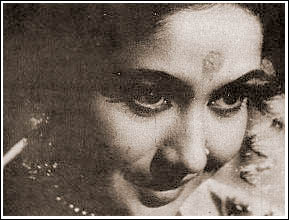Meena Kumari, whose name in India has now become synonymous with the tragic heroine, shot into stardom in the early fifties with the release of Baiju Bawra (1952). The daughter of a Parsee theatre actor, Mahajabeen acted in her first film at the age of six. She took on the name Meena Kumari for Vijay Bhatt’s immensely popular musical Baiju Bawra. Her early films were rather unremarkable mythologicals.Meena Kumari entered the limelight at a time when histrionics were taking over from glamour (as epitomized by such beauties as Naseem, Veena, Sofia and Jayshree). She therefore heralded a new era of actresses that included Nargis, Nimmi, Suchitra Sen and Nutan.By 1953, Meena Kumari had starred in three other commercially successful films: Daera, Do Bigha Zameen and Parineeta. Parineeta became a turning point in her career. Her evocative portrayal of the perennially suffering Indian woman struck a responsive chord in millions of women. She was never really able to shake off this image of a tragidienne, and at times this severely impeded her in the exercise of the full range of her histrionic talents. The following years saw her appear in a number of films, where she played many, largely indistinguishable, self-mortifying women.
However, her studied reserve, chaste diction and — most of all — extraordinary voice, that struck the right balance between the erotic and the pathetic, ensured her place in the hearts of the Indian movie-going public. One reason for this popularity was her private life, which at times rivaled the plot of any movie. She married Kamal Amrohi who directed some of her best films.
However, her strong independent spirit would not be subordinated by her husband’s genius and they eventually separated in 1964. She was also a poet in her own right, and was able to lend to the characters she played a certain poetic tenderness and intensity. A collection of her poems in Urdu under the pen name Naaz was published after her death.
Sahib Bibi Aur Ghulam (Master, Mistress and Servant 1962) became in more than a symbolic way the crossroads of her life. Like the heroine of the film, she increasingly took to drink and embarked on the road to gradual ‘ruin’. Her screen image of a tormented, self-mortifying woman became an extension of her own personality.
Pakeezah (1971), jointly conceived with her husband, was completed shortly before her tragic death in 1972 and was her last great performance. The image of her limpid eyes and tremulous voice remains to epitomize the tragic heroine of the Hindi film.
Sources
Rajadhyaksha, Ashish; Willemen, Paul. Encyclopedia of Indian Cinema. London: British Film Institute; New Delhi: Oxford University Press, 1994
Mahmood, Hameeduddin. The Kaleidoscope of Indian Cinema. NewDelhi: East West Press, 1974
Brief Filmography
Baiju Bawra (1952)
Daera, Do Bigha Zameen, Parineeta (1953)
Bandish (1956)
Sahib Bibi Aur Ghulam (1963)
Pakeezah (1972)



